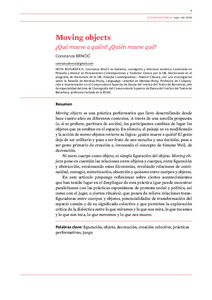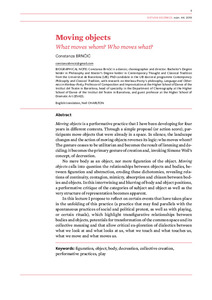| dc.contributor.author | Brnčić, Constanza | |
| dc.date.accessioned | 2021-01-29T10:18:42Z | |
| dc.date.available | 2021-01-29T10:18:42Z | |
| dc.date.issued | 2019 | |
| dc.identifier.issn | 2385-362X | |
| dc.identifier.issn | 0212-3819 | |
| dc.identifier.uri | http://hdl.handle.net/20.500.11904/1194 | |
| dc.description.abstract | <p><em>Moving objects</em> is a performative practice that I have been developing for four years in different contexts. Through a simple proposal (or action score), participants move objects that were already in a space. In silence, the landscape changes and the action of moving objects reverses its logic: who moves whom? The gesture ceases to be utilitarian and becomes the result of listening and deciding; it becomes the primary gesture of creation and, invoking Simone Weil’s concept, of decreation.</p>
<p>No mere body as an object, nor mere figuration of the object. <em>Moving objects</em> calls into question the relationships between objects and bodies, between figuration and abstraction, eroding these dichotomies, revealing relations of continuity, contagion, mimicry, absorption and chiasm between bodies and objects. In this intertwining and blurring of body and object positions, a performative critique of the categories of subject and object as well as the very structure of representation becomes apparent.</p>
<p>In this lecture I propose to reflect on certain events that have taken place in the unfolding of this practice (a practice that may find parallels with the spontaneous practices of social and political protest, as well as with playing, or certain rituals), which highlight transfigurative relationships between bodies and objects, potentials for transformation of the common space and its collective meaning and that allow critical ex-ploration of dialectics between what we look at and what looks at us, what we touch and what touches us, what we move and what moves us.</p> | |
| dc.description.abstract | <p><em>Moving objects</em> es una práctica performativa que llevo desarrollando desde hace cuatro años en diferentes contextos. A través de una sencilla propuesta (o, si se prefiere, partitura de acción), los participantes cambian de lugar los objetos que ya estaban en el espacio. En silencio, el paisaje se va modificando y la acción de mover objetos revierte su lógica: ¿quién mueve a quién? El gesto deja de ser utilitario y pasa a ser fruto de una escucha y una decisión, pasa a ser gesto primario de creación e, invocando el concepto de Simone Weil, de decreación.</p>
<p>Ni mero cuerpo como objeto, ni simple figuración del objeto. <em>Moving objects</em> pone en cuestión las relaciones entre objetos y cuerpos, entre figuración y abstracción, erosionando estas dicotomías, revelando relaciones de continuidad, contagio, mimetización, absorción y quiasmo entre cuerpos y objetos.</p>
<p>En este artículo propongo reflexionar sobre ciertos acontecimientos que han tenido lugar en el despliegue de esta práctica (que puede encontrar paralelismos con las prácticas espontáneas de protesta social y política, así como con el jugar, o ciertos rituales), que ponen de relieve relaciones transfiguradoras entre cuerpos y objetos, potencialidades de transformación del espacio común y de su significado colectivo y que permiten la exploración crítica de la dialéctica entre lo que miramos y lo que nos mira, lo que tocamos y lo que nos toca, lo que movemos y lo que nos mueve.</p> | |
| dc.relation.ispartof | Estudis escènics: quaderns de l'Institut del Teatre. 2019, Núm. 44 | |
| dc.title | "Moving objects" Who moves whom? Who moves what? | |
| dc.type | Article | |
| dc.date.updated | 2021-01-29T10:18:43Z | |
| dc.rights.access | Open Access | |



